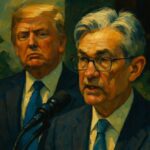
Navigating Market Turbulence: Risk-Off Sentiment Fuels Shift to Safe Havens
Tháng 4 4, 2025
Forex Forecast: EUR/USD, USD/JPY & GBP/USD Insights Before US Jobs Report
Tháng 4 4, 2025China’s Counter-Tariffs: Analyzing Recent Developments in Global Markets
In an increasingly interconnected world, the financial markets are often influenced by geopolitical actions. The recent saga surrounding the United States and China’s trade policies illustrates this dynamic and its substantial impact on global markets.
The US’s Increased Tariffs on Chinese Goods
The Trump administration has taken a significant step by escalating tariffs on Chinese goods, bringing them to an unprecedented 54%. This figure incorporates the original 20% tariff, bolstered by an additional 34% imposed to counteract what the White House describes as unfair trade practices. This move aligns with the administration’s long-standing position to protect American industries and labor from perceived economic aggression by foreign competitors.
Such aggressive tariffs serve as a double-edged sword; while aimed at protecting domestic interests, they can also lead to retaliatory measures and escalate trade disputes. These economic policies have injected an atmosphere of uncertainty into the markets, making investors wary of potential fallout.
China’s Strategic Retaliation
In a swift and strategically calculated response, China has announced its own set of countermeasures, including a 34% tariff on all American goods starting April 10. This significant retaliation not only impacts the direct trade dynamic between the two nations but also signals to global markets that China is willing to strike back against perceived economic hostilities. Moreover, China’s decision to add US entities to its export control and “unreliable entity” lists further limits US access to Chinese markets, escalating the stakes.
China’s President Xi Jinping convened over 40 top global CEOs to address escalating U.S.-China trade tensions, emphasizing the need for international stability and collaboration. The meeting highlighted China’s commitment to being a favorable investment destination, assuring fair treatment for foreign companies despite U.S. tariffs. The blog discusses China’s strategies to enhance partnerships globally and its ongoing role in sustaining economic stability. Read more here.
This tit-for-tat approach raises the question of how far each nation is willing to go, and the implications could be far-reaching, affecting everything from consumer prices to supply chains across multiple sectors.
Market Reactions and Global Implications
The apparent escalation in the trade war has led to increased volatility in the markets. Following the announcement of the new tariffs, equities not only felt the strain but also displayed significant decline indicators, with the S&P 500 experiencing a nearly 5% drop. Furthermore, stock index futures in both the United States and Europe reflected investor uncertainty, suggesting a broader concern over economic repercussions.
Market participants are now weighing potential scenarios of economic shocks, corporate profit impacts, and shifts in consumer behavior. The tumultuous environment can lead to a cautious approach by investors, as they navigate the complexities of these trade tensions.
Complications in Global Trade Relations
The ongoing conflict complicates global trade relations dramatically, as both the United States and China trade barbs about violating World Trade Organization (WTO) rules. Moreover, China has formally filed a lawsuit with the WTO to contest these tariffs, aiming to challenge the legitimacy of US trade actions on a global platform. This action underscores the potential for a protracted dispute that could redefine trade norms and expectations.
As this contentious situation unfolds, global markets remain on high alert, with traders and investors likely to remain vigilant about the developments in US-China relations. The outcomes of these tariffs and retaliations could not only reshape trade policies but also influence economic trajectories worldwide.
In summary, as China and the United States engage in this tit-for-tat trade war, the implications for global markets are multifaceted and profound. The ongoing tensions highlight the need for careful monitoring and strategic assessment by all stakeholders in the eyes of an unforeseen economic future.

